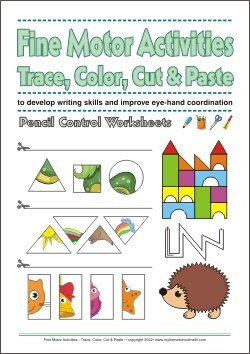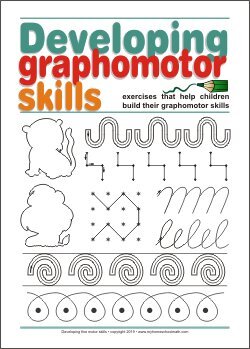Graphomotor skills
Development of graphomotor skills
What exactly are graphomotor skills and how are they developed?
In simple terms, graphomotor skills are the ability to hold a writing instrument correctly and guide it smoothly, using the sophisticated, rhythmic movements of writing. This includes the proper grip of the pen or pencil, the coordination of hand movements and eye-hand coordination. We most often discuss these skills before children start school.
Many children are familiar with letters and numbers even before they enter school, and some can even write them. However, most children master the correct writing technique by the first grade. Developing such a complex skill as writing requires certain skills, including fine motor skills (coordination of hand and finger movements), perception, eye-hand coordination, spatial awareness, sequencing, and memory.
It can be said that the development of graphomotor skills and all related skills begins around the age of 18 months and continues until school age. Besides natural development, graphomotor skills can also be improved through frequent practice. Therefore, children should be provided with activities that support this development.
Development of fine motor skills, visual perception and hand-eye coordination at an early age
In order for a child to master writing skills, they must first go through complete motor development, starting with the development of gross motor skills: sitting, crawling, walking, climbing, stacking blocks, playing ball games, and so on.
This process then continues with the development of fine motor skills, which refers to the precise movements of the arms and hands. At first, children may grasp objects with their fist and then progress to using their index finger and thumb. The development of these skills is greatly supported by toys of various shapes and designs: books, pencils, pull-along toys, which help develop skills such as grasping, holding, releasing, transferring objects from one hand to the other, catching a ball with both hands, stacking blocks or puzzles, inserting objects into corresponding openings, and picking up small objects with the thumb and forefinger.
There are also important everyday activities for children such as dressing and undressing, opening and closing buttons and zippers, hanging up their jacket, self-feeding, removing wrappers, tying shoelaces, flipping through books, wiping dishes, and more. Although these activities may seem insignificant to parents at first glance, they are crucial for developing the practical skills that school-age children need.
During play or daily activities, it is important for children to practice their dexterity. This means that adults should only assist with tasks they cannot do alone, allowing children to explore and improve their skills through their own efforts.
Development of graphomotor skills in children
The prerequisite for successful graphomotor activity is the development of fine motor skills — the coordination of hand movements.
A one-year-old child begins to hold a crayon, grasping it with the whole hand, and starts to doodle on paper. At this stage, the child turns the pages of a book by turning several pages at once. Then, at the age of two or two and a half years, the child can turn pages one at a time and also holds a pencil with the thumb, index, and middle finger, drawing vertical and horizontal lines.
From the ages of three to five, the child holds a pencil with three fingers and moves the entire hand while writing. Most three-year-olds can draw a circle, by the fourth year they can draw a square, and by the age of five they can draw a triangle.
Around the age of four and a half and no later than six years, the child begins to hold the pencil regularly and with the correct grip: with the fingertips (holding the pencil with the thumb, index and middle finger at the same time) and moving only the fingers while writing. This grip provides maximum flexibility and control, enabling the child to write smoothly and neatly later on.
At this stage, parents might start to correct their child's grip, as it is much easier to teach correct pencil holding at the beginning of learning to write than to correct an incorrect grip later. The longer a child uses an "incorrect" writing posture, the more difficult it becomes to change it.
Some children begin to scribble, paint, draw, or copy written symbols very early, while others show no interest in pencil activities. If a child does not want to draw or paint, it is not advisable to force them to do graphomotor exercises.
Of course, parents do not have to give up on encouraging these activities, but they can engage in other activities that promote graphomotor skills, such as:
- Drawing with the index finger in sand in a sandbag or on flour on the table
- Painting with finger paints
- Drawing with sidewalk chalk on a blackboard or sidewalk
- Stringing beads
- Pouring water into different containers
- Cutting, folding, and gluing paper
- Forming soft balls from paper or paper towels
- Shaping various figures with modeling clay
- Assembling puzzles or stacking blocks
- Drawing with fingers, chalk, pastels, or brushes
Over time, through the right selection of activities that are fun and interesting, the child will reach a stage of development where they can hold a pencil without difficulty. At this point the child is then ready for other graphomotor exercises such as coloring books, mazes, and so on.
It is very important to support every activity of the child and to encourage the exploration of their own abilities. At this stage, the quality of the finished work is not so important.
Visual perception
To prepare the child for the responsibilities expected in school and in life in general, the child must develop visual perception, attention, and memory properly. Visual perception helps to understand, analyze and interpret the environment. It is of great importance for writing, reading, math and other skills necessary for school success.
The exercises can be started with a child from the age of three, but the complexity of the tasks should be adjusted according to the child's age.
One of the simplest activities to develop visual perception is to visualize similarities, differences, and things that are the same or different, and to notice differences in images (for example Spot the Differences).
Games like "What doesn't belong?" and "Find the images" also help to develop attention. Copying patterns is not only a great exercise for developing graphomotor skills, but also for improving attention.
Writing letters
Before a child successfully masters writing skills, the following is necessary:
- The dominant hand must be established (the hand used for writing), and hand dominance should be developed. By the age of five, most children tend to use one hand for most activities. Simply let the child decide which hand to hold the pencil with, and don't force them to use their right hand.
- The child must maintain the correct body position while writing — at least two-thirds of the forearm should rest on the table to provide a stable starting point for hand movements. The writing arm should be able to move freely and not used as support. The other arm serves as a body support and helps correct the position of the paper.
- Proper grip and control of the writing instrument must be learned. The pencil is held in the so-called pincer grip (or three-point grip): the thumb and index finger grip the pencil like a pair of tweezers, while the middle finger provides a support surface for the pencil.
- The pressure applied while writing must be adjusted appropriately.
- Hand-eye coordination must be well developed.
- The child can color within the lines of a picture.
- The child can cut simple figures with scissors.
- The child can smoothly follow lines with their eyes.
- The child can recognize and differentiate shapes.
- The child can copy basic shapes (circle, square, triangle, diamond).
Stages of graphomotor skill development
10 to 18 months – The child holds the pencil with the whole hand and scribbles. Scribbles occur unintentionally and during scribbling the child grasps the upper end of the pencil.
2 years – During this period, it becomes clearer which hand the child uses as the dominant (working) hand and which as the supporting hand. The child begins to hold the pencil with fingers, scribbles on paper, and makes horizontal, vertical and circular lines (using the three-point grip or four-point grip).
3 years – The child holds the pencil with three fingers and can copy horizontal and vertical lines and circles or create faces. They cut large shapes with scissors and can craft with paper and glue.
4-5 years – The child begins to hold the pen with a three-point grip using the fingertips (thumb, index finger and middle finger) and can draw diagonal lines, squares, as well as some letters and numbers. They can also color within specified boundaries. During this time, the fine motor movements become increasingly precise and the child can catch a ball with their hands and thread small beads.
5-6 years – The child holds the pencil correctly (holding the pencil with thumb, index, and middle finger at the same time) and the pressure applied while writing is adjusted appropriately. The child can draw a triangle, write their own name and copy most uppercase letters. They can write or draw well within boundaries and cut out a figure along a line.
Around the age of 7, writing movements become increasingly fluid. The individual handwriting style continues to develop further.
What is important when learning and practicing?
All children develop differently, learn to write at their own pace and have different motivations.
Positive motivation plays a crucial role in learning!
Motivate children to learn with fun!
Do not force children into lessons!
You can find some graphomotor exercises for early support here:






